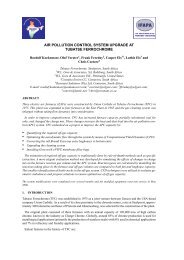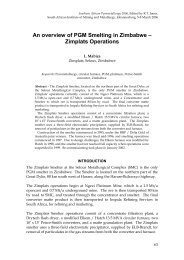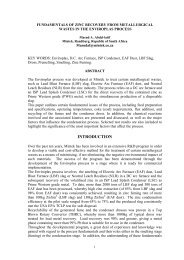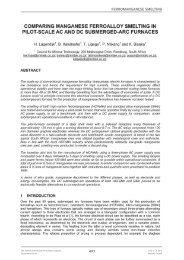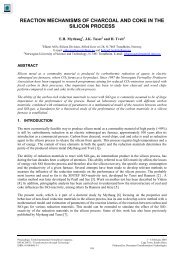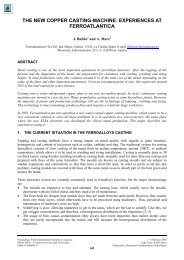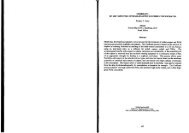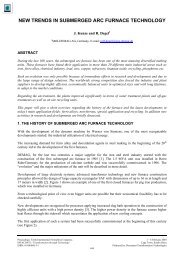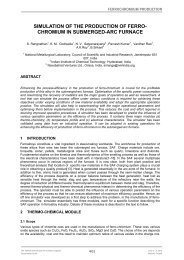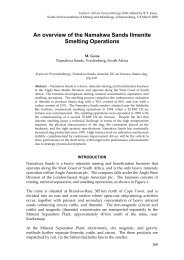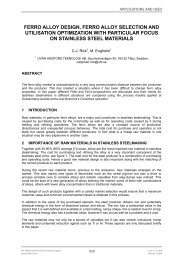Reduction of Chromium Oxide in Stainless Steel Slags - Pyro.co.za
Reduction of Chromium Oxide in Stainless Steel Slags - Pyro.co.za
Reduction of Chromium Oxide in Stainless Steel Slags - Pyro.co.za
- No tags were found...
You also want an ePaper? Increase the reach of your titles
YUMPU automatically turns print PDFs into web optimized ePapers that Google loves.
dissolution <strong>of</strong> MgO・Cr 2 Os <strong>in</strong>to bulk slag is one <strong>of</strong> rate determ<strong>in</strong><strong>in</strong>g steps, where the solidity <strong>of</strong> MgO・Cr 2 O 3at 1873K is approximately 1 to 2 as mass%(Cr) (Figure 2).Fujita et al [9] <strong>in</strong>vestigated the smelt<strong>in</strong>g reduction behavior <strong>of</strong> prereduced chrome ore pellet us<strong>in</strong>g a 70kgcarbon saturated Fe-40%Cr with the slag (CaO/SiO 2 =1, Al 2 O 3 17%, MgO 17 mass%) together with <strong>co</strong>ke <strong>of</strong>5-10 mm size.Argon was blown through a porous plug at the furnace bottom. They found that at the first stage mass%(Cr)was reduced from 12 to 2 with a <strong>co</strong>nstant reduction rate, demonstrat<strong>in</strong>g that dissolution <strong>of</strong> MgO・Cr 2 O 3 <strong>in</strong>tobulk slag is a rate determ<strong>in</strong><strong>in</strong>g step. After % (Cr) was lowered below 2, the first order reaction was observed,suggest<strong>in</strong>g mass transfer <strong>co</strong>ntrol <strong>of</strong> (Cr) <strong>in</strong> slag (Figure 6). The rate <strong>co</strong>nstant was found to be <strong>co</strong>nstant up tomass% (MgO+Al 2 O 3 )>45 and as this parameter exceeds 45%, it significantly dropped (Figure 7). The Cr<strong>co</strong>ntent <strong>of</strong> the last slag was 0.3 mass%.Figure 6. Change <strong>in</strong> chromium <strong>co</strong>ntent <strong>of</strong> slag dur<strong>in</strong>gsmelt<strong>in</strong>g reduction <strong>of</strong> chromite ore with time [9].Figure 7. Effect <strong>of</strong> (MgO)+(Al 2 O 3 ) <strong>co</strong>ntent on thefirst order rate <strong>co</strong>nstant <strong>of</strong> reduction <strong>of</strong> Cr 2 O 3 [9].Miyamoto et al [10] recently <strong>in</strong>vestigated the smelt<strong>in</strong>g reduction behavior <strong>of</strong> Cr 2 O 3 <strong>in</strong> the slag to simulatechromium re<strong>co</strong>very from the slag to produce sta<strong>in</strong>less crude metal before decarburi<strong>za</strong>tion. They melted 70kg<strong>of</strong> Fe-C(-Cr) together with 3kg <strong>of</strong> the CaO-SiO 2 -Cr 2 O 3 -FeO-MgO-Al 2 O 3 slag with CaO/SiO 2 =2.5 at 1873Kand measured the reduction rate <strong>of</strong> Cr 2 O 3 as functions <strong>of</strong> <strong>in</strong>itial (Cr 2 O 3 ), (Al 2 O 3 ), C and Cr <strong>co</strong>ntents. All slags<strong>co</strong>nta<strong>in</strong>ed some solid oxide phases such as MgO・Cr 2 O 3 , FeO・Cr 2 O 3 , 2CaO・SiO 2 etc. depend<strong>in</strong>g on slag<strong>co</strong>mposition. Their typical <strong>in</strong>itial slag <strong>co</strong>mposition was CaO 39.3, SiO 2 15.7, Cr 2 O 3 35, FeO 5.0, MgO 5.0mass %.Their f<strong>in</strong>d<strong>in</strong>gs are summarized as follows:The additions <strong>of</strong> Al 2 O 3 and CaF 2 and lower CaO/SiO 2 ratio enhance the reduction <strong>of</strong> Cr 2 O 3 due to <strong>in</strong>creasedmass transfer rate <strong>of</strong> chromium <strong>in</strong> slag through <strong>in</strong>creased proportions <strong>of</strong> molten phase or less solid phase. Asthe reduction progressed, the proportion <strong>of</strong> solid phase decreased as shown <strong>in</strong> Figure 8. However, thoseprocedures lead to excessive erosion <strong>of</strong> MgO refractory so that they claim that the optimum slag <strong>co</strong>mpositionis CaO/SiO2=2.5 and mass%Al 2 O 3 ≒15 without CaF 2 . They also found the carbon <strong>co</strong>ntent up to 1 mass%<strong>in</strong>creases the reduction rate but beyond this <strong>co</strong>ntent the rate leveled <strong>of</strong>f. Increase <strong>in</strong> <strong>in</strong>itial chromium <strong>of</strong><strong>co</strong>ntent <strong>of</strong> the metal decreased the reduction rate and that <strong>of</strong> the slag <strong>in</strong>creased the rate. They <strong>co</strong>ncluded thereduction is mix-<strong>co</strong>ntrolled by the rate <strong>of</strong> dissolution <strong>of</strong> solid oxide (MgO・Cr 2 O 3 etc.) and that <strong>of</strong> masstransfer <strong>of</strong> chromium <strong>in</strong> metal.



